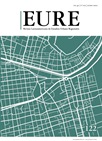Estructura espacial y densidad de población en la ZMVM 1995-2010: evolución de un sistema urbano policéntrico.
DOI:
https://doi.org/10.4067/S0250-71612015000100004Palabras clave:
centros urbanos, asentamientos humanos, distribución espacial.Resumen
En este trabajo se estima el efecto del policentrismo sobre la densidad deÍpoblación en la Zona Metropolitana del Valle de México (ZMVM) entre 1995 y 2010.
Los modelos teóricos policéntricos postulan que la densidad de la población debe caer a medida que la distancia a los centros de empleo aumenta. Los resultados confirman esta hipótesis a pesar de la fuerte inercia monocéntrica del área. Sin embargo, se advierteÍ una creciente desconexión entre los espacios de empleo y los de vivienda, lo cual impediría reducir la distancia de los desplazamientos entre el lugar de residencia y el de trabajo. Un producto destacable del ejercicio llevado a cabo es que la capacidad estructurante que tiene la infraestructura viaria principal tiende a reforzarse en detrimento del efecto que ejercen los subcentros de empleo sobre la densidad de población.
Descargas
Publicado
Cómo citar
Número
Sección
Licencia
Derechos de autor 2015 Revista EURE - Revista de Estudios Urbano Regionales

Esta obra está bajo una licencia internacional Creative Commons Atribución 4.0.
Al momento de aceptar la publicación de sus artículos, los autores deberán formalizar la cesión de derechos de autor a EURE, según las condiciones establecidas por la Revista.
Ésta establece que el autor autoriza a EURE de manera gratuita, exclusiva e ilimitada a reproducir, editar, publicar, distribuir, publicitar, comercializar y traducir el artículo, a cualquier soporte conocido o por conocer y desarrollar.
Del mismo modo, los autores aseguran que el artículo propuesto es original, no publicado y no propuesto para tal fin a otro medio de difusión.


